Macdonald's entering China Market
VerifiedAdded on 2023/05/28
|20
|4640
|101
AI Summary
This paper explores Macdonald's market entry strategy into the Chinese market, including China's business environment, market entry theories, and the best market entry model for Macdonald's with a focus on the advantages and disadvantages.
Contribute Materials
Your contribution can guide someone’s learning journey. Share your
documents today.
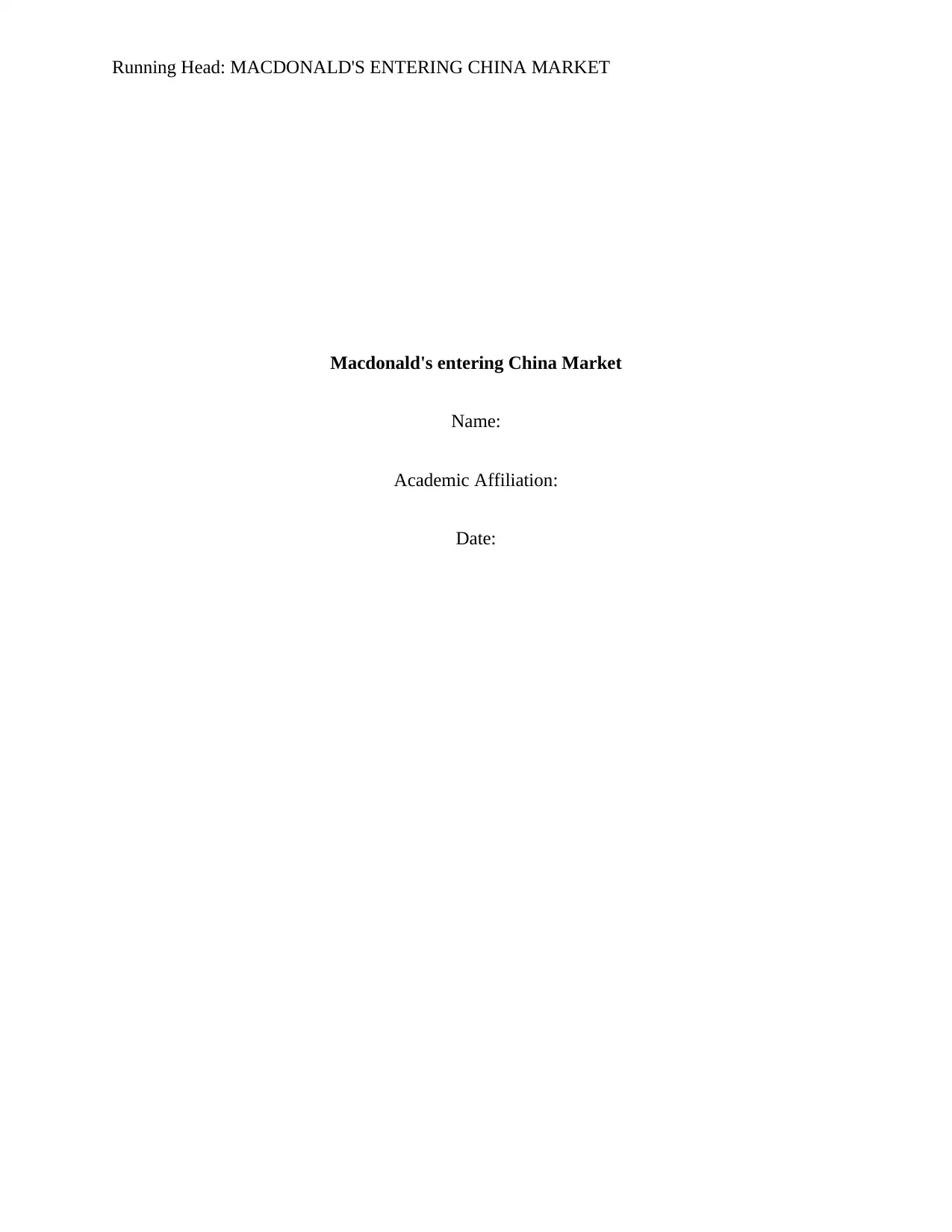
Running Head: MACDONALD'S ENTERING CHINA MARKET
Macdonald's entering China Market
Name:
Academic Affiliation:
Date:
Macdonald's entering China Market
Name:
Academic Affiliation:
Date:
Secure Best Marks with AI Grader
Need help grading? Try our AI Grader for instant feedback on your assignments.
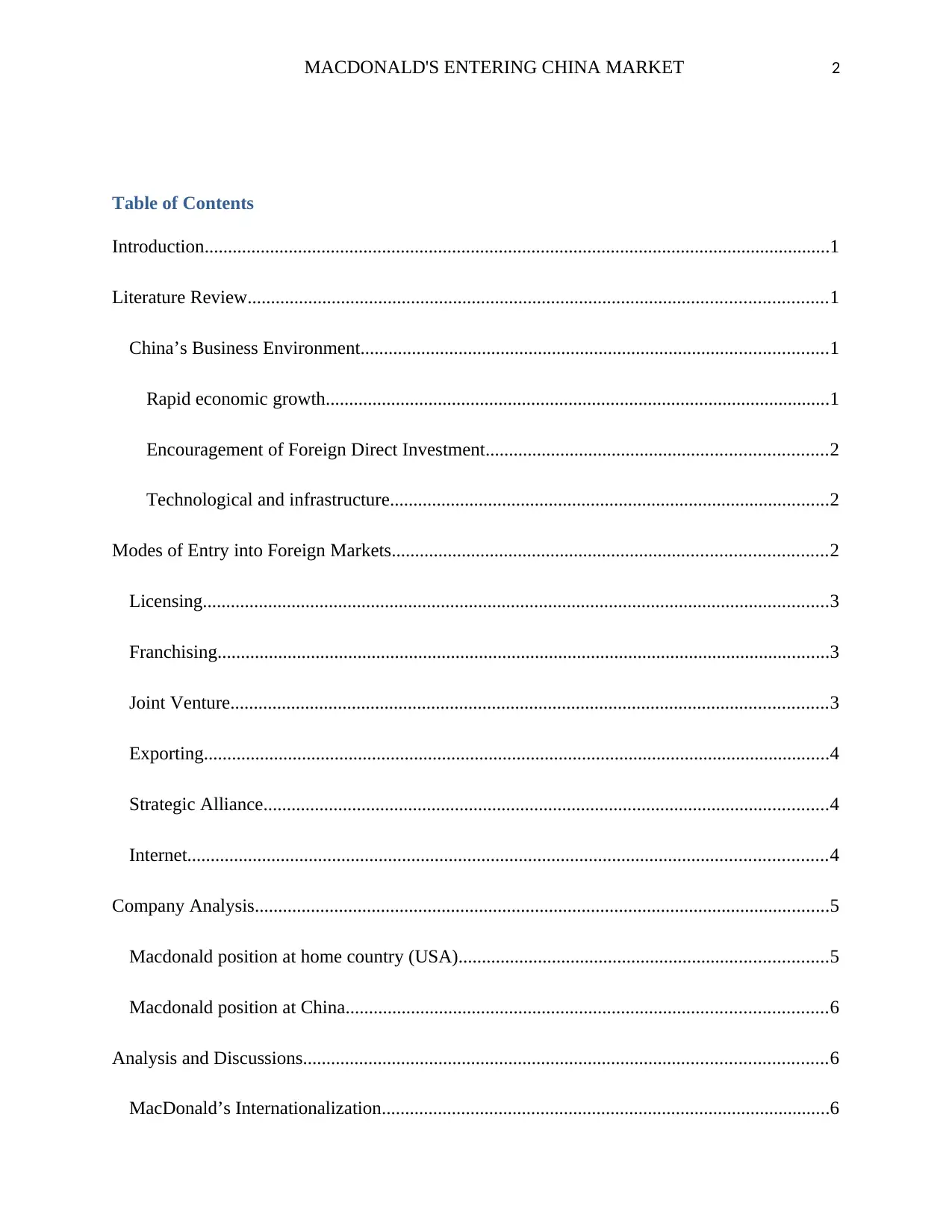
MACDONALD'S ENTERING CHINA MARKET 2
Table of Contents
Introduction......................................................................................................................................1
Literature Review............................................................................................................................1
China’s Business Environment....................................................................................................1
Rapid economic growth............................................................................................................1
Encouragement of Foreign Direct Investment.........................................................................2
Technological and infrastructure..............................................................................................2
Modes of Entry into Foreign Markets.............................................................................................2
Licensing......................................................................................................................................3
Franchising...................................................................................................................................3
Joint Venture................................................................................................................................3
Exporting......................................................................................................................................4
Strategic Alliance.........................................................................................................................4
Internet.........................................................................................................................................4
Company Analysis...........................................................................................................................5
Macdonald position at home country (USA)...............................................................................5
Macdonald position at China.......................................................................................................6
Analysis and Discussions................................................................................................................6
MacDonald’s Internationalization................................................................................................6
Table of Contents
Introduction......................................................................................................................................1
Literature Review............................................................................................................................1
China’s Business Environment....................................................................................................1
Rapid economic growth............................................................................................................1
Encouragement of Foreign Direct Investment.........................................................................2
Technological and infrastructure..............................................................................................2
Modes of Entry into Foreign Markets.............................................................................................2
Licensing......................................................................................................................................3
Franchising...................................................................................................................................3
Joint Venture................................................................................................................................3
Exporting......................................................................................................................................4
Strategic Alliance.........................................................................................................................4
Internet.........................................................................................................................................4
Company Analysis...........................................................................................................................5
Macdonald position at home country (USA)...............................................................................5
Macdonald position at China.......................................................................................................6
Analysis and Discussions................................................................................................................6
MacDonald’s Internationalization................................................................................................6
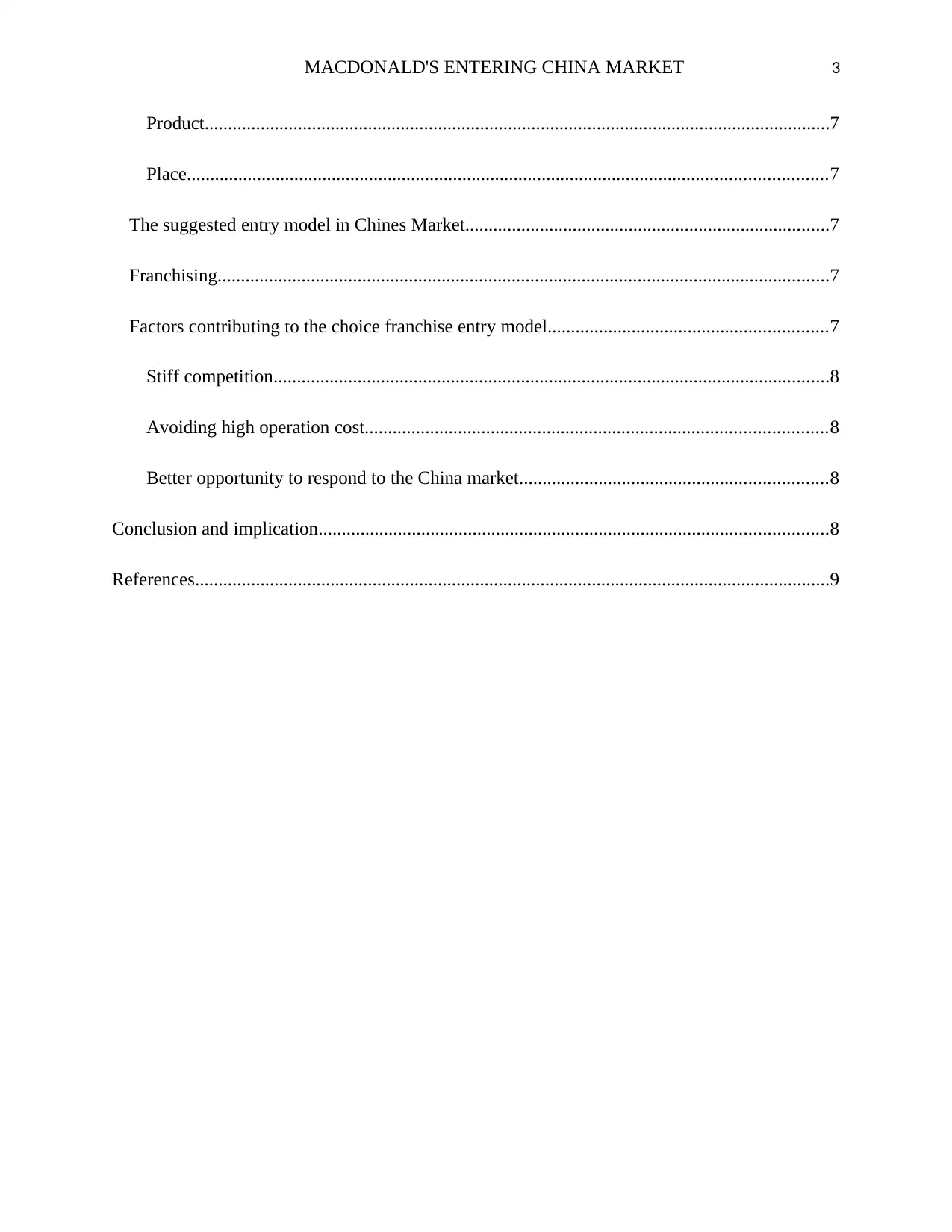
MACDONALD'S ENTERING CHINA MARKET 3
Product......................................................................................................................................7
Place.........................................................................................................................................7
The suggested entry model in Chines Market..............................................................................7
Franchising...................................................................................................................................7
Factors contributing to the choice franchise entry model............................................................7
Stiff competition.......................................................................................................................8
Avoiding high operation cost...................................................................................................8
Better opportunity to respond to the China market..................................................................8
Conclusion and implication.............................................................................................................8
References........................................................................................................................................9
Product......................................................................................................................................7
Place.........................................................................................................................................7
The suggested entry model in Chines Market..............................................................................7
Franchising...................................................................................................................................7
Factors contributing to the choice franchise entry model............................................................7
Stiff competition.......................................................................................................................8
Avoiding high operation cost...................................................................................................8
Better opportunity to respond to the China market..................................................................8
Conclusion and implication.............................................................................................................8
References........................................................................................................................................9
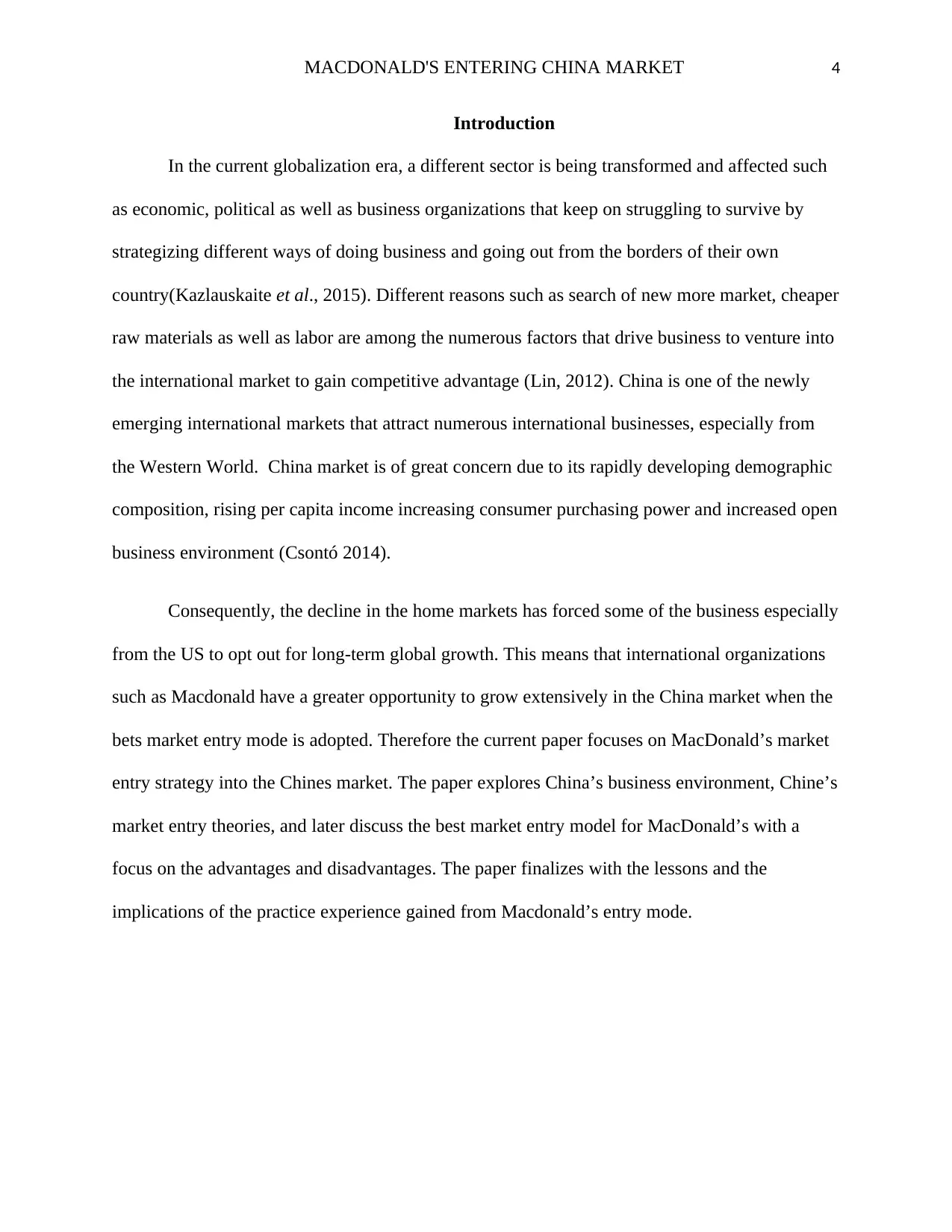
MACDONALD'S ENTERING CHINA MARKET 4
Introduction
In the current globalization era, a different sector is being transformed and affected such
as economic, political as well as business organizations that keep on struggling to survive by
strategizing different ways of doing business and going out from the borders of their own
country(Kazlauskaite et al., 2015). Different reasons such as search of new more market, cheaper
raw materials as well as labor are among the numerous factors that drive business to venture into
the international market to gain competitive advantage (Lin, 2012). China is one of the newly
emerging international markets that attract numerous international businesses, especially from
the Western World. China market is of great concern due to its rapidly developing demographic
composition, rising per capita income increasing consumer purchasing power and increased open
business environment (Csontó 2014).
Consequently, the decline in the home markets has forced some of the business especially
from the US to opt out for long-term global growth. This means that international organizations
such as Macdonald have a greater opportunity to grow extensively in the China market when the
bets market entry mode is adopted. Therefore the current paper focuses on MacDonald’s market
entry strategy into the Chines market. The paper explores China’s business environment, Chine’s
market entry theories, and later discuss the best market entry model for MacDonald’s with a
focus on the advantages and disadvantages. The paper finalizes with the lessons and the
implications of the practice experience gained from Macdonald’s entry mode.
Introduction
In the current globalization era, a different sector is being transformed and affected such
as economic, political as well as business organizations that keep on struggling to survive by
strategizing different ways of doing business and going out from the borders of their own
country(Kazlauskaite et al., 2015). Different reasons such as search of new more market, cheaper
raw materials as well as labor are among the numerous factors that drive business to venture into
the international market to gain competitive advantage (Lin, 2012). China is one of the newly
emerging international markets that attract numerous international businesses, especially from
the Western World. China market is of great concern due to its rapidly developing demographic
composition, rising per capita income increasing consumer purchasing power and increased open
business environment (Csontó 2014).
Consequently, the decline in the home markets has forced some of the business especially
from the US to opt out for long-term global growth. This means that international organizations
such as Macdonald have a greater opportunity to grow extensively in the China market when the
bets market entry mode is adopted. Therefore the current paper focuses on MacDonald’s market
entry strategy into the Chines market. The paper explores China’s business environment, Chine’s
market entry theories, and later discuss the best market entry model for MacDonald’s with a
focus on the advantages and disadvantages. The paper finalizes with the lessons and the
implications of the practice experience gained from Macdonald’s entry mode.
Secure Best Marks with AI Grader
Need help grading? Try our AI Grader for instant feedback on your assignments.
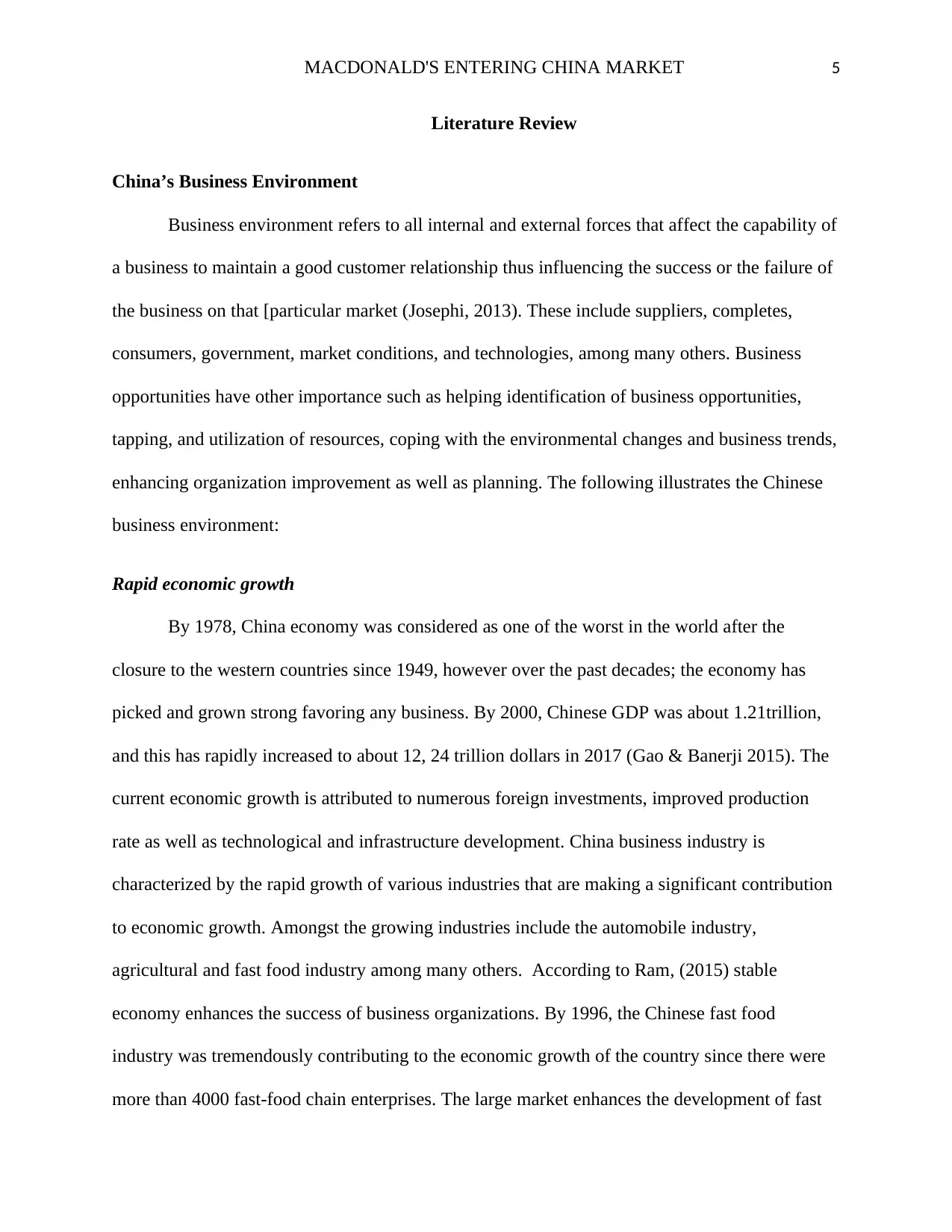
MACDONALD'S ENTERING CHINA MARKET 5
Literature Review
China’s Business Environment
Business environment refers to all internal and external forces that affect the capability of
a business to maintain a good customer relationship thus influencing the success or the failure of
the business on that [particular market (Josephi, 2013). These include suppliers, completes,
consumers, government, market conditions, and technologies, among many others. Business
opportunities have other importance such as helping identification of business opportunities,
tapping, and utilization of resources, coping with the environmental changes and business trends,
enhancing organization improvement as well as planning. The following illustrates the Chinese
business environment:
Rapid economic growth
By 1978, China economy was considered as one of the worst in the world after the
closure to the western countries since 1949, however over the past decades; the economy has
picked and grown strong favoring any business. By 2000, Chinese GDP was about 1.21trillion,
and this has rapidly increased to about 12, 24 trillion dollars in 2017 (Gao & Banerji 2015). The
current economic growth is attributed to numerous foreign investments, improved production
rate as well as technological and infrastructure development. China business industry is
characterized by the rapid growth of various industries that are making a significant contribution
to economic growth. Amongst the growing industries include the automobile industry,
agricultural and fast food industry among many others. According to Ram, (2015) stable
economy enhances the success of business organizations. By 1996, the Chinese fast food
industry was tremendously contributing to the economic growth of the country since there were
more than 4000 fast-food chain enterprises. The large market enhances the development of fast
Literature Review
China’s Business Environment
Business environment refers to all internal and external forces that affect the capability of
a business to maintain a good customer relationship thus influencing the success or the failure of
the business on that [particular market (Josephi, 2013). These include suppliers, completes,
consumers, government, market conditions, and technologies, among many others. Business
opportunities have other importance such as helping identification of business opportunities,
tapping, and utilization of resources, coping with the environmental changes and business trends,
enhancing organization improvement as well as planning. The following illustrates the Chinese
business environment:
Rapid economic growth
By 1978, China economy was considered as one of the worst in the world after the
closure to the western countries since 1949, however over the past decades; the economy has
picked and grown strong favoring any business. By 2000, Chinese GDP was about 1.21trillion,
and this has rapidly increased to about 12, 24 trillion dollars in 2017 (Gao & Banerji 2015). The
current economic growth is attributed to numerous foreign investments, improved production
rate as well as technological and infrastructure development. China business industry is
characterized by the rapid growth of various industries that are making a significant contribution
to economic growth. Amongst the growing industries include the automobile industry,
agricultural and fast food industry among many others. According to Ram, (2015) stable
economy enhances the success of business organizations. By 1996, the Chinese fast food
industry was tremendously contributing to the economic growth of the country since there were
more than 4000 fast-food chain enterprises. The large market enhances the development of fast

MACDONALD'S ENTERING CHINA MARKET 6
food in China. However, Macdonald might be affected due to the difference in cultural
composition.
Encouragement of Foreign Direct Investment
Foreign investment has a significant impact on the development of the country's
economy. Resmini & Siedschlag, (2013).Over the past decades, the Chines government has
been encouraging investor onto the country through establishing favorable laws. In 2019, China
foreign investment laws were revised. The establishments of the Chinese National Development
and Reform Commission (NDRC in 2006) formed a major turnaround point for the chines
economy since the commission majored to creating a good relationship between China and other
foreign investors through adopting various relaxed foreign investment rights and lows. Both
chains are that the US is currently on conscious delegation meeting that aims at resolving the
countries bruising trade disputes. Currently, the chain is one of the largest beneficiaries of the
FDI, with over 100 countries directly investing in the chain. The FDI currently accounts to more
than 27% of the value-added production.
Technological and infrastructure
Along with rapid economic growth, China is experiencing strong and rapid technological
and infrastructure growth. The rapid technological growth is attributed to the increased scientific
research on various aspects such as nuclear energy, next-generation communication, and
supercomputers among many others. The developed electronic devices are expected to other
countries thus attracting large among of revenue collection (Jiang, Qiang, Fan & Zhang, 2018).
Consequently is currently on the motion of developing various infrastructures such as roads and
communication system, providing a good business environment for both domestic and the
food in China. However, Macdonald might be affected due to the difference in cultural
composition.
Encouragement of Foreign Direct Investment
Foreign investment has a significant impact on the development of the country's
economy. Resmini & Siedschlag, (2013).Over the past decades, the Chines government has
been encouraging investor onto the country through establishing favorable laws. In 2019, China
foreign investment laws were revised. The establishments of the Chinese National Development
and Reform Commission (NDRC in 2006) formed a major turnaround point for the chines
economy since the commission majored to creating a good relationship between China and other
foreign investors through adopting various relaxed foreign investment rights and lows. Both
chains are that the US is currently on conscious delegation meeting that aims at resolving the
countries bruising trade disputes. Currently, the chain is one of the largest beneficiaries of the
FDI, with over 100 countries directly investing in the chain. The FDI currently accounts to more
than 27% of the value-added production.
Technological and infrastructure
Along with rapid economic growth, China is experiencing strong and rapid technological
and infrastructure growth. The rapid technological growth is attributed to the increased scientific
research on various aspects such as nuclear energy, next-generation communication, and
supercomputers among many others. The developed electronic devices are expected to other
countries thus attracting large among of revenue collection (Jiang, Qiang, Fan & Zhang, 2018).
Consequently is currently on the motion of developing various infrastructures such as roads and
communication system, providing a good business environment for both domestic and the
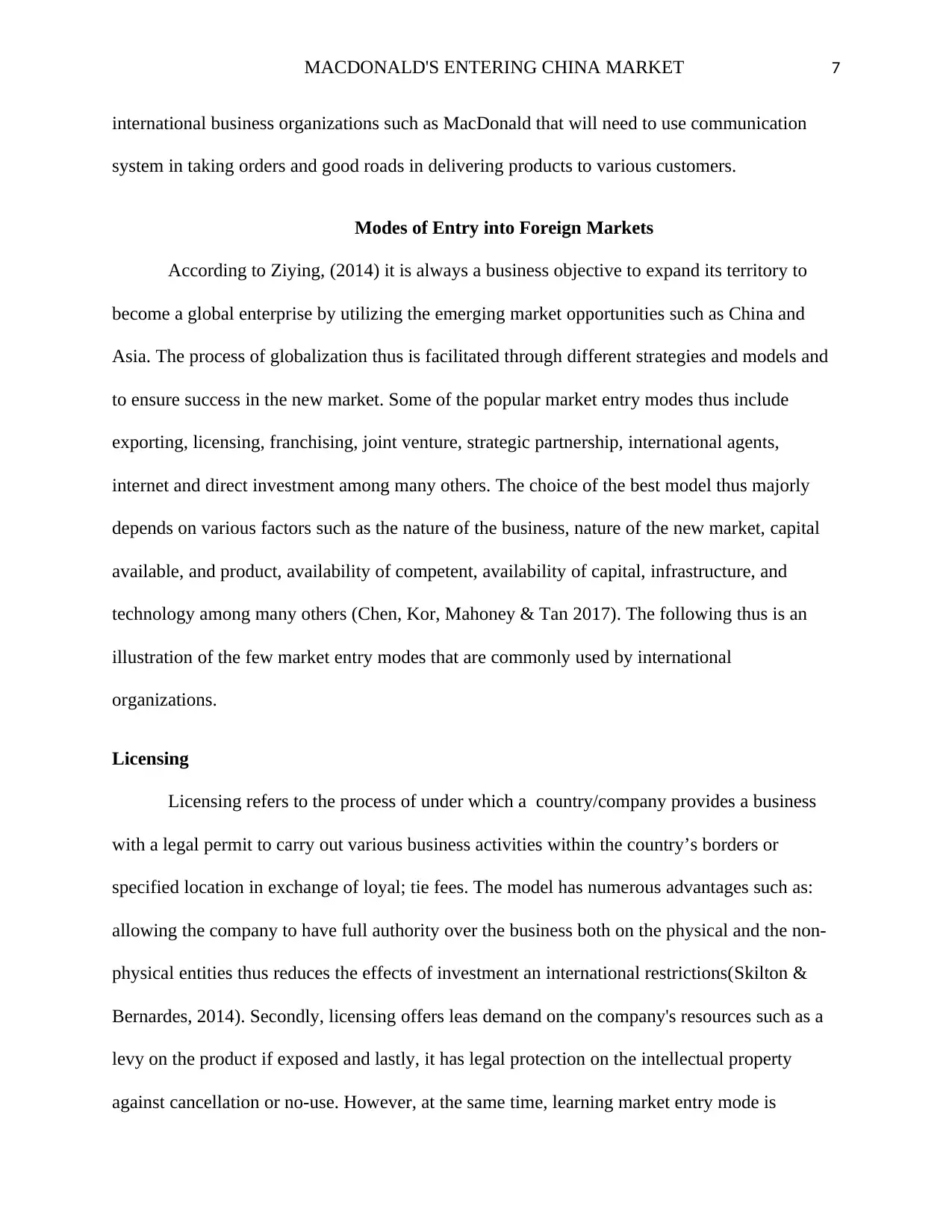
MACDONALD'S ENTERING CHINA MARKET 7
international business organizations such as MacDonald that will need to use communication
system in taking orders and good roads in delivering products to various customers.
Modes of Entry into Foreign Markets
According to Ziying, (2014) it is always a business objective to expand its territory to
become a global enterprise by utilizing the emerging market opportunities such as China and
Asia. The process of globalization thus is facilitated through different strategies and models and
to ensure success in the new market. Some of the popular market entry modes thus include
exporting, licensing, franchising, joint venture, strategic partnership, international agents,
internet and direct investment among many others. The choice of the best model thus majorly
depends on various factors such as the nature of the business, nature of the new market, capital
available, and product, availability of competent, availability of capital, infrastructure, and
technology among many others (Chen, Kor, Mahoney & Tan 2017). The following thus is an
illustration of the few market entry modes that are commonly used by international
organizations.
Licensing
Licensing refers to the process of under which a country/company provides a business
with a legal permit to carry out various business activities within the country’s borders or
specified location in exchange of loyal; tie fees. The model has numerous advantages such as:
allowing the company to have full authority over the business both on the physical and the non-
physical entities thus reduces the effects of investment an international restrictions(Skilton &
Bernardes, 2014). Secondly, licensing offers leas demand on the company's resources such as a
levy on the product if exposed and lastly, it has legal protection on the intellectual property
against cancellation or no-use. However, at the same time, learning market entry mode is
international business organizations such as MacDonald that will need to use communication
system in taking orders and good roads in delivering products to various customers.
Modes of Entry into Foreign Markets
According to Ziying, (2014) it is always a business objective to expand its territory to
become a global enterprise by utilizing the emerging market opportunities such as China and
Asia. The process of globalization thus is facilitated through different strategies and models and
to ensure success in the new market. Some of the popular market entry modes thus include
exporting, licensing, franchising, joint venture, strategic partnership, international agents,
internet and direct investment among many others. The choice of the best model thus majorly
depends on various factors such as the nature of the business, nature of the new market, capital
available, and product, availability of competent, availability of capital, infrastructure, and
technology among many others (Chen, Kor, Mahoney & Tan 2017). The following thus is an
illustration of the few market entry modes that are commonly used by international
organizations.
Licensing
Licensing refers to the process of under which a country/company provides a business
with a legal permit to carry out various business activities within the country’s borders or
specified location in exchange of loyal; tie fees. The model has numerous advantages such as:
allowing the company to have full authority over the business both on the physical and the non-
physical entities thus reduces the effects of investment an international restrictions(Skilton &
Bernardes, 2014). Secondly, licensing offers leas demand on the company's resources such as a
levy on the product if exposed and lastly, it has legal protection on the intellectual property
against cancellation or no-use. However, at the same time, learning market entry mode is
Paraphrase This Document
Need a fresh take? Get an instant paraphrase of this document with our AI Paraphraser
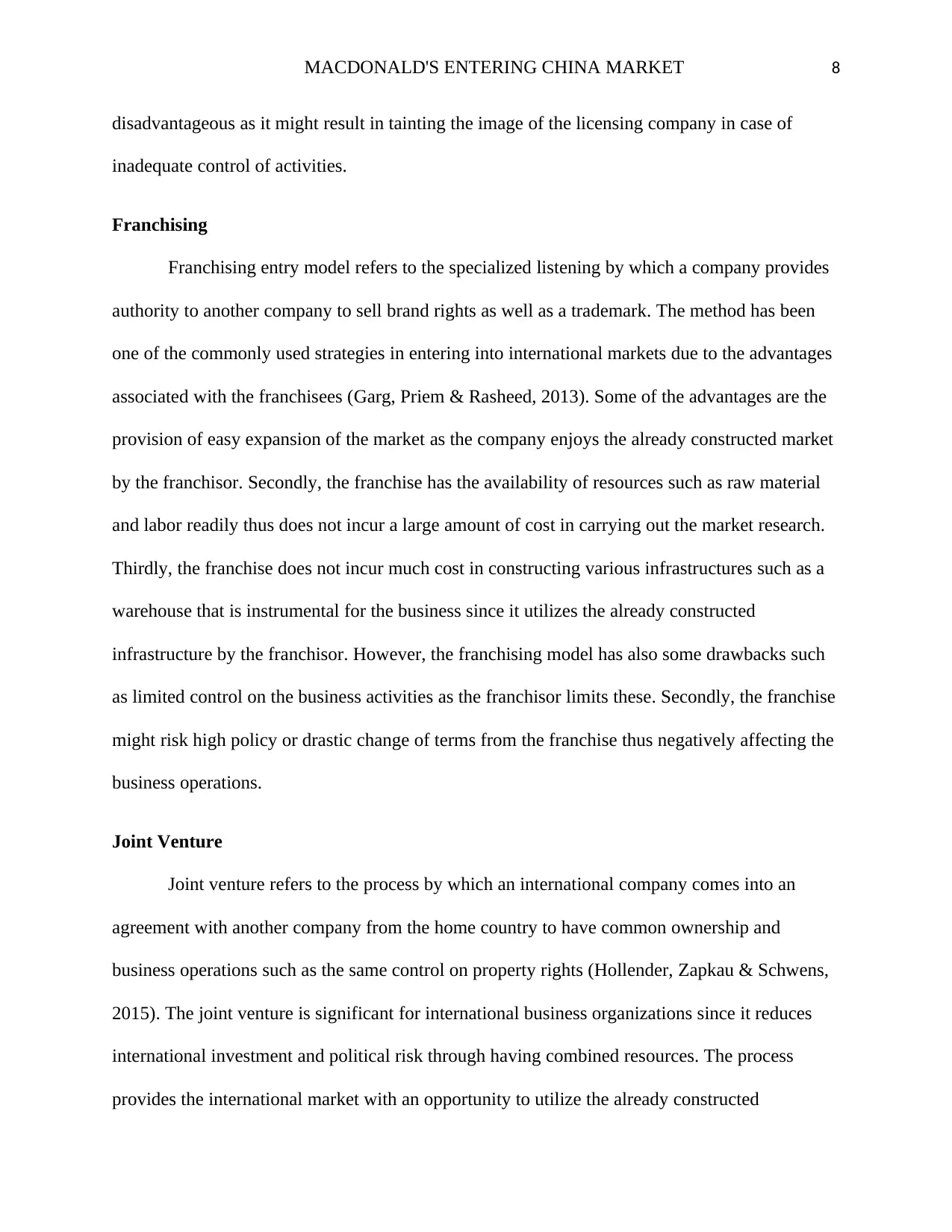
MACDONALD'S ENTERING CHINA MARKET 8
disadvantageous as it might result in tainting the image of the licensing company in case of
inadequate control of activities.
Franchising
Franchising entry model refers to the specialized listening by which a company provides
authority to another company to sell brand rights as well as a trademark. The method has been
one of the commonly used strategies in entering into international markets due to the advantages
associated with the franchisees (Garg, Priem & Rasheed, 2013). Some of the advantages are the
provision of easy expansion of the market as the company enjoys the already constructed market
by the franchisor. Secondly, the franchise has the availability of resources such as raw material
and labor readily thus does not incur a large amount of cost in carrying out the market research.
Thirdly, the franchise does not incur much cost in constructing various infrastructures such as a
warehouse that is instrumental for the business since it utilizes the already constructed
infrastructure by the franchisor. However, the franchising model has also some drawbacks such
as limited control on the business activities as the franchisor limits these. Secondly, the franchise
might risk high policy or drastic change of terms from the franchise thus negatively affecting the
business operations.
Joint Venture
Joint venture refers to the process by which an international company comes into an
agreement with another company from the home country to have common ownership and
business operations such as the same control on property rights (Hollender, Zapkau & Schwens,
2015). The joint venture is significant for international business organizations since it reduces
international investment and political risk through having combined resources. The process
provides the international market with an opportunity to utilize the already constructed
disadvantageous as it might result in tainting the image of the licensing company in case of
inadequate control of activities.
Franchising
Franchising entry model refers to the specialized listening by which a company provides
authority to another company to sell brand rights as well as a trademark. The method has been
one of the commonly used strategies in entering into international markets due to the advantages
associated with the franchisees (Garg, Priem & Rasheed, 2013). Some of the advantages are the
provision of easy expansion of the market as the company enjoys the already constructed market
by the franchisor. Secondly, the franchise has the availability of resources such as raw material
and labor readily thus does not incur a large amount of cost in carrying out the market research.
Thirdly, the franchise does not incur much cost in constructing various infrastructures such as a
warehouse that is instrumental for the business since it utilizes the already constructed
infrastructure by the franchisor. However, the franchising model has also some drawbacks such
as limited control on the business activities as the franchisor limits these. Secondly, the franchise
might risk high policy or drastic change of terms from the franchise thus negatively affecting the
business operations.
Joint Venture
Joint venture refers to the process by which an international company comes into an
agreement with another company from the home country to have common ownership and
business operations such as the same control on property rights (Hollender, Zapkau & Schwens,
2015). The joint venture is significant for international business organizations since it reduces
international investment and political risk through having combined resources. The process
provides the international market with an opportunity to utilize the already constructed
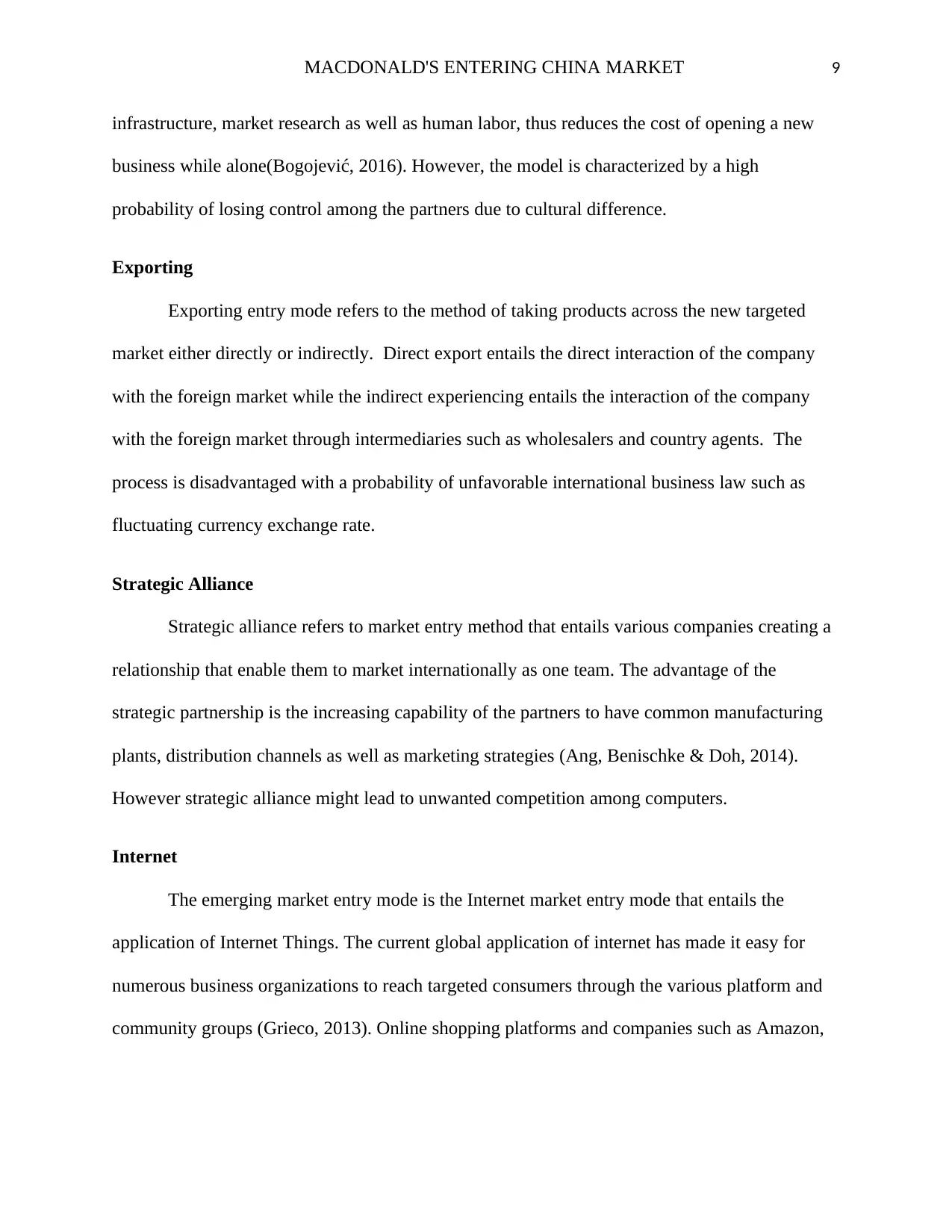
MACDONALD'S ENTERING CHINA MARKET 9
infrastructure, market research as well as human labor, thus reduces the cost of opening a new
business while alone(Bogojević, 2016). However, the model is characterized by a high
probability of losing control among the partners due to cultural difference.
Exporting
Exporting entry mode refers to the method of taking products across the new targeted
market either directly or indirectly. Direct export entails the direct interaction of the company
with the foreign market while the indirect experiencing entails the interaction of the company
with the foreign market through intermediaries such as wholesalers and country agents. The
process is disadvantaged with a probability of unfavorable international business law such as
fluctuating currency exchange rate.
Strategic Alliance
Strategic alliance refers to market entry method that entails various companies creating a
relationship that enable them to market internationally as one team. The advantage of the
strategic partnership is the increasing capability of the partners to have common manufacturing
plants, distribution channels as well as marketing strategies (Ang, Benischke & Doh, 2014).
However strategic alliance might lead to unwanted competition among computers.
Internet
The emerging market entry mode is the Internet market entry mode that entails the
application of Internet Things. The current global application of internet has made it easy for
numerous business organizations to reach targeted consumers through the various platform and
community groups (Grieco, 2013). Online shopping platforms and companies such as Amazon,
infrastructure, market research as well as human labor, thus reduces the cost of opening a new
business while alone(Bogojević, 2016). However, the model is characterized by a high
probability of losing control among the partners due to cultural difference.
Exporting
Exporting entry mode refers to the method of taking products across the new targeted
market either directly or indirectly. Direct export entails the direct interaction of the company
with the foreign market while the indirect experiencing entails the interaction of the company
with the foreign market through intermediaries such as wholesalers and country agents. The
process is disadvantaged with a probability of unfavorable international business law such as
fluctuating currency exchange rate.
Strategic Alliance
Strategic alliance refers to market entry method that entails various companies creating a
relationship that enable them to market internationally as one team. The advantage of the
strategic partnership is the increasing capability of the partners to have common manufacturing
plants, distribution channels as well as marketing strategies (Ang, Benischke & Doh, 2014).
However strategic alliance might lead to unwanted competition among computers.
Internet
The emerging market entry mode is the Internet market entry mode that entails the
application of Internet Things. The current global application of internet has made it easy for
numerous business organizations to reach targeted consumers through the various platform and
community groups (Grieco, 2013). Online shopping platforms and companies such as Amazon,
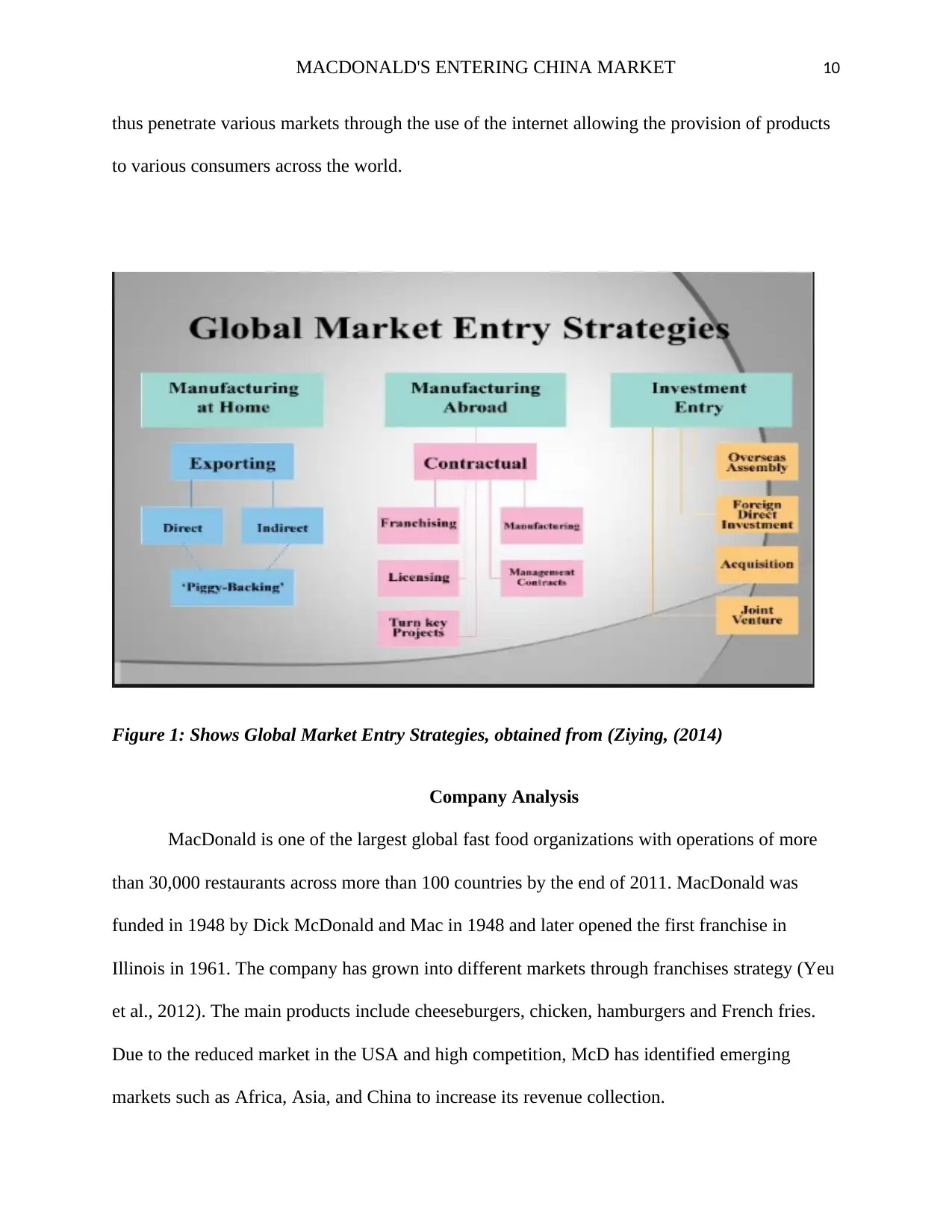
MACDONALD'S ENTERING CHINA MARKET 10
thus penetrate various markets through the use of the internet allowing the provision of products
to various consumers across the world.
Figure 1: Shows Global Market Entry Strategies, obtained from (Ziying, (2014)
Company Analysis
MacDonald is one of the largest global fast food organizations with operations of more
than 30,000 restaurants across more than 100 countries by the end of 2011. MacDonald was
funded in 1948 by Dick McDonald and Mac in 1948 and later opened the first franchise in
Illinois in 1961. The company has grown into different markets through franchises strategy (Yeu
et al., 2012). The main products include cheeseburgers, chicken, hamburgers and French fries.
Due to the reduced market in the USA and high competition, McD has identified emerging
markets such as Africa, Asia, and China to increase its revenue collection.
thus penetrate various markets through the use of the internet allowing the provision of products
to various consumers across the world.
Figure 1: Shows Global Market Entry Strategies, obtained from (Ziying, (2014)
Company Analysis
MacDonald is one of the largest global fast food organizations with operations of more
than 30,000 restaurants across more than 100 countries by the end of 2011. MacDonald was
funded in 1948 by Dick McDonald and Mac in 1948 and later opened the first franchise in
Illinois in 1961. The company has grown into different markets through franchises strategy (Yeu
et al., 2012). The main products include cheeseburgers, chicken, hamburgers and French fries.
Due to the reduced market in the USA and high competition, McD has identified emerging
markets such as Africa, Asia, and China to increase its revenue collection.
Secure Best Marks with AI Grader
Need help grading? Try our AI Grader for instant feedback on your assignments.

MACDONALD'S ENTERING CHINA MARKET 11
Macdonald position at home country (USA)
Statistics show that McD's has the largest markets share in the USA followed by closed
competitors Yum! Brands. MacDonald has about 88 billion U.S dollars brand value that is more
durable than the closes cosmetics. According to the US consumer survey of 2016, fast food about
44% of American families takes fast food; thus this means that McD's is the largest contributor
to the daily meals. More than 50 million customers take fast food daily according to the
American Beverage Association(Baena, 2012). MacDonald’s dictates 17% of the total USA Fast
food market, followed by Yum’s at 10.8% and 58.9% by other small, fast food restaurants.
Figure 2: Shows MacDonald’s Fast Food Position in the USA, obtained from (Baena, 2012).
Macdonald position at home country (USA)
Statistics show that McD's has the largest markets share in the USA followed by closed
competitors Yum! Brands. MacDonald has about 88 billion U.S dollars brand value that is more
durable than the closes cosmetics. According to the US consumer survey of 2016, fast food about
44% of American families takes fast food; thus this means that McD's is the largest contributor
to the daily meals. More than 50 million customers take fast food daily according to the
American Beverage Association(Baena, 2012). MacDonald’s dictates 17% of the total USA Fast
food market, followed by Yum’s at 10.8% and 58.9% by other small, fast food restaurants.
Figure 2: Shows MacDonald’s Fast Food Position in the USA, obtained from (Baena, 2012).

MACDONALD'S ENTERING CHINA MARKET 12
Macdonald position at China
Chinese fast food industry dated back in the 1980s and developed rapidly at the rate of
20% per annual growth contributing to about 15% to 25% of the national economic growth (Yu
& Ramanathan, 2011). By the end of 1996, there were more than 800 professional fast food
companies with over 4000 chain enterprises. Chines fast food is characterized by both
availabilities of Chinese and western culture. KFC was the first American fast food chain to enter
into the Chinese market, thus making it the largest market share in China. KFC has more than
5,000 restaurants in China translating to 11.6% while McD’s hold about 5.6% with about 2,500
restaurants across the country (Shi, Nie, Cai & Wang, 2016). This means that KFC covers twice
the share of McD's, thus reducing the revenue collection of the latter. The large KFC’s Chinese
market share is attributed to the capability of the restaurant to integrate the local state of the
menu such as Dragon and twister.
Analysis and Discussions
MacDonald’s Internationalization
Over the past years, McD has used the same pattern to internalize into different new
markets. McD always established a contract of “area development” with an already existing local
business. Through the concept, the local business owners the right to spread McD's brand into
various respective regions; however, McD's chain entry has been different:
Macdonald position at China
Chinese fast food industry dated back in the 1980s and developed rapidly at the rate of
20% per annual growth contributing to about 15% to 25% of the national economic growth (Yu
& Ramanathan, 2011). By the end of 1996, there were more than 800 professional fast food
companies with over 4000 chain enterprises. Chines fast food is characterized by both
availabilities of Chinese and western culture. KFC was the first American fast food chain to enter
into the Chinese market, thus making it the largest market share in China. KFC has more than
5,000 restaurants in China translating to 11.6% while McD’s hold about 5.6% with about 2,500
restaurants across the country (Shi, Nie, Cai & Wang, 2016). This means that KFC covers twice
the share of McD's, thus reducing the revenue collection of the latter. The large KFC’s Chinese
market share is attributed to the capability of the restaurant to integrate the local state of the
menu such as Dragon and twister.
Analysis and Discussions
MacDonald’s Internationalization
Over the past years, McD has used the same pattern to internalize into different new
markets. McD always established a contract of “area development” with an already existing local
business. Through the concept, the local business owners the right to spread McD's brand into
various respective regions; however, McD's chain entry has been different:
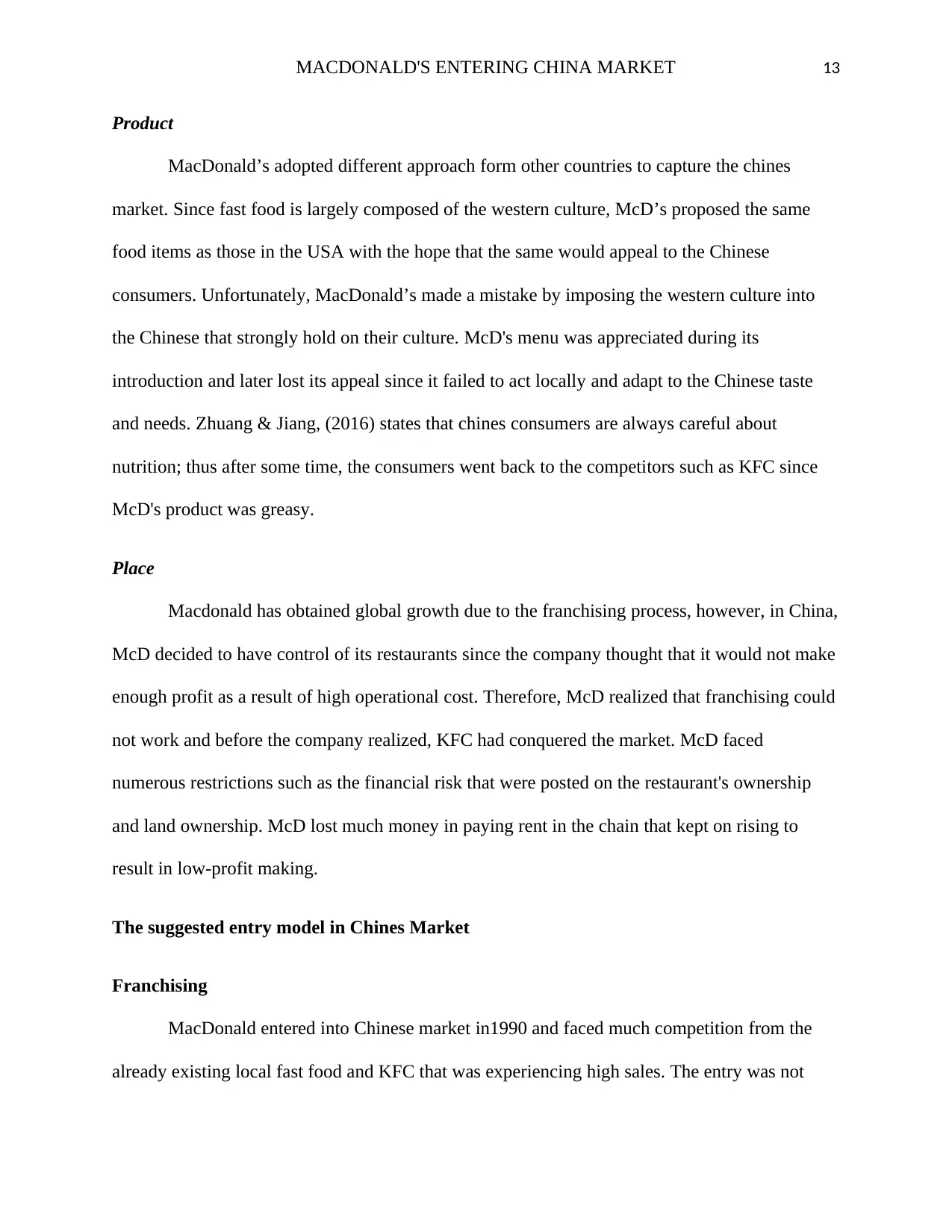
MACDONALD'S ENTERING CHINA MARKET 13
Product
MacDonald’s adopted different approach form other countries to capture the chines
market. Since fast food is largely composed of the western culture, McD’s proposed the same
food items as those in the USA with the hope that the same would appeal to the Chinese
consumers. Unfortunately, MacDonald’s made a mistake by imposing the western culture into
the Chinese that strongly hold on their culture. McD's menu was appreciated during its
introduction and later lost its appeal since it failed to act locally and adapt to the Chinese taste
and needs. Zhuang & Jiang, (2016) states that chines consumers are always careful about
nutrition; thus after some time, the consumers went back to the competitors such as KFC since
McD's product was greasy.
Place
Macdonald has obtained global growth due to the franchising process, however, in China,
McD decided to have control of its restaurants since the company thought that it would not make
enough profit as a result of high operational cost. Therefore, McD realized that franchising could
not work and before the company realized, KFC had conquered the market. McD faced
numerous restrictions such as the financial risk that were posted on the restaurant's ownership
and land ownership. McD lost much money in paying rent in the chain that kept on rising to
result in low-profit making.
The suggested entry model in Chines Market
Franchising
MacDonald entered into Chinese market in1990 and faced much competition from the
already existing local fast food and KFC that was experiencing high sales. The entry was not
Product
MacDonald’s adopted different approach form other countries to capture the chines
market. Since fast food is largely composed of the western culture, McD’s proposed the same
food items as those in the USA with the hope that the same would appeal to the Chinese
consumers. Unfortunately, MacDonald’s made a mistake by imposing the western culture into
the Chinese that strongly hold on their culture. McD's menu was appreciated during its
introduction and later lost its appeal since it failed to act locally and adapt to the Chinese taste
and needs. Zhuang & Jiang, (2016) states that chines consumers are always careful about
nutrition; thus after some time, the consumers went back to the competitors such as KFC since
McD's product was greasy.
Place
Macdonald has obtained global growth due to the franchising process, however, in China,
McD decided to have control of its restaurants since the company thought that it would not make
enough profit as a result of high operational cost. Therefore, McD realized that franchising could
not work and before the company realized, KFC had conquered the market. McD faced
numerous restrictions such as the financial risk that were posted on the restaurant's ownership
and land ownership. McD lost much money in paying rent in the chain that kept on rising to
result in low-profit making.
The suggested entry model in Chines Market
Franchising
MacDonald entered into Chinese market in1990 and faced much competition from the
already existing local fast food and KFC that was experiencing high sales. The entry was not
Paraphrase This Document
Need a fresh take? Get an instant paraphrase of this document with our AI Paraphraser
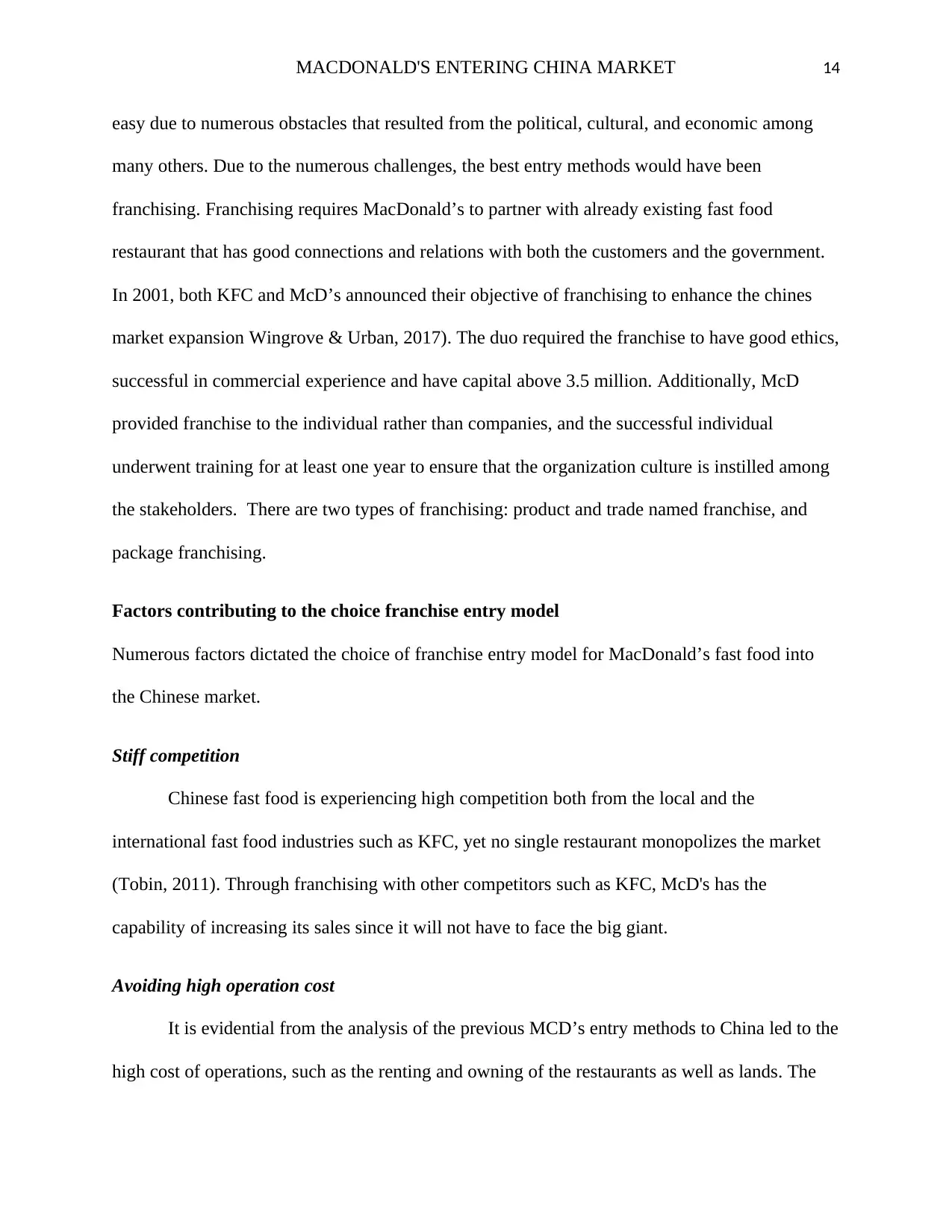
MACDONALD'S ENTERING CHINA MARKET 14
easy due to numerous obstacles that resulted from the political, cultural, and economic among
many others. Due to the numerous challenges, the best entry methods would have been
franchising. Franchising requires MacDonald’s to partner with already existing fast food
restaurant that has good connections and relations with both the customers and the government.
In 2001, both KFC and McD’s announced their objective of franchising to enhance the chines
market expansion Wingrove & Urban, 2017). The duo required the franchise to have good ethics,
successful in commercial experience and have capital above 3.5 million. Additionally, McD
provided franchise to the individual rather than companies, and the successful individual
underwent training for at least one year to ensure that the organization culture is instilled among
the stakeholders. There are two types of franchising: product and trade named franchise, and
package franchising.
Factors contributing to the choice franchise entry model
Numerous factors dictated the choice of franchise entry model for MacDonald’s fast food into
the Chinese market.
Stiff competition
Chinese fast food is experiencing high competition both from the local and the
international fast food industries such as KFC, yet no single restaurant monopolizes the market
(Tobin, 2011). Through franchising with other competitors such as KFC, McD's has the
capability of increasing its sales since it will not have to face the big giant.
Avoiding high operation cost
It is evidential from the analysis of the previous MCD’s entry methods to China led to the
high cost of operations, such as the renting and owning of the restaurants as well as lands. The
easy due to numerous obstacles that resulted from the political, cultural, and economic among
many others. Due to the numerous challenges, the best entry methods would have been
franchising. Franchising requires MacDonald’s to partner with already existing fast food
restaurant that has good connections and relations with both the customers and the government.
In 2001, both KFC and McD’s announced their objective of franchising to enhance the chines
market expansion Wingrove & Urban, 2017). The duo required the franchise to have good ethics,
successful in commercial experience and have capital above 3.5 million. Additionally, McD
provided franchise to the individual rather than companies, and the successful individual
underwent training for at least one year to ensure that the organization culture is instilled among
the stakeholders. There are two types of franchising: product and trade named franchise, and
package franchising.
Factors contributing to the choice franchise entry model
Numerous factors dictated the choice of franchise entry model for MacDonald’s fast food into
the Chinese market.
Stiff competition
Chinese fast food is experiencing high competition both from the local and the
international fast food industries such as KFC, yet no single restaurant monopolizes the market
(Tobin, 2011). Through franchising with other competitors such as KFC, McD's has the
capability of increasing its sales since it will not have to face the big giant.
Avoiding high operation cost
It is evidential from the analysis of the previous MCD’s entry methods to China led to the
high cost of operations, such as the renting and owning of the restaurants as well as lands. The
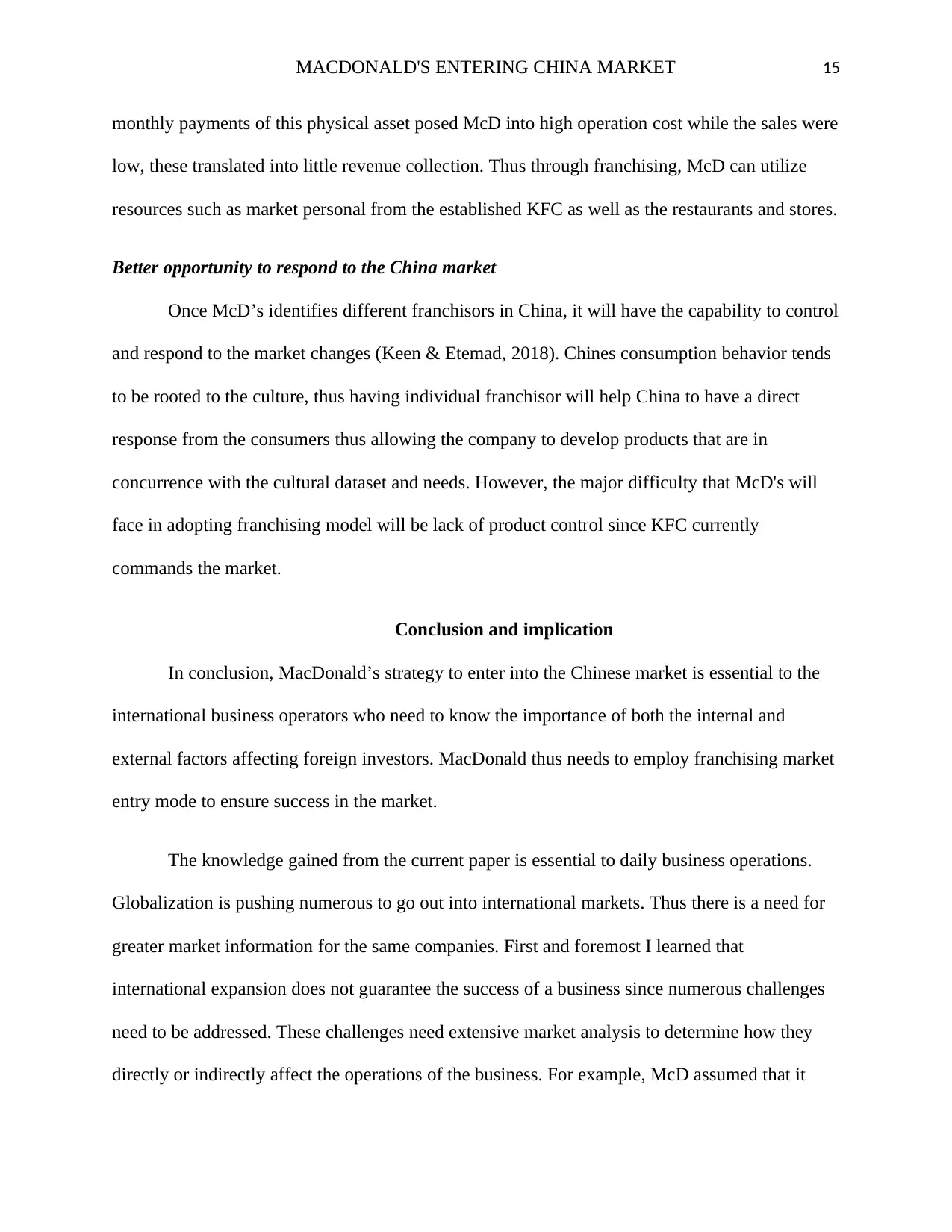
MACDONALD'S ENTERING CHINA MARKET 15
monthly payments of this physical asset posed McD into high operation cost while the sales were
low, these translated into little revenue collection. Thus through franchising, McD can utilize
resources such as market personal from the established KFC as well as the restaurants and stores.
Better opportunity to respond to the China market
Once McD’s identifies different franchisors in China, it will have the capability to control
and respond to the market changes (Keen & Etemad, 2018). Chines consumption behavior tends
to be rooted to the culture, thus having individual franchisor will help China to have a direct
response from the consumers thus allowing the company to develop products that are in
concurrence with the cultural dataset and needs. However, the major difficulty that McD's will
face in adopting franchising model will be lack of product control since KFC currently
commands the market.
Conclusion and implication
In conclusion, MacDonald’s strategy to enter into the Chinese market is essential to the
international business operators who need to know the importance of both the internal and
external factors affecting foreign investors. MacDonald thus needs to employ franchising market
entry mode to ensure success in the market.
The knowledge gained from the current paper is essential to daily business operations.
Globalization is pushing numerous to go out into international markets. Thus there is a need for
greater market information for the same companies. First and foremost I learned that
international expansion does not guarantee the success of a business since numerous challenges
need to be addressed. These challenges need extensive market analysis to determine how they
directly or indirectly affect the operations of the business. For example, McD assumed that it
monthly payments of this physical asset posed McD into high operation cost while the sales were
low, these translated into little revenue collection. Thus through franchising, McD can utilize
resources such as market personal from the established KFC as well as the restaurants and stores.
Better opportunity to respond to the China market
Once McD’s identifies different franchisors in China, it will have the capability to control
and respond to the market changes (Keen & Etemad, 2018). Chines consumption behavior tends
to be rooted to the culture, thus having individual franchisor will help China to have a direct
response from the consumers thus allowing the company to develop products that are in
concurrence with the cultural dataset and needs. However, the major difficulty that McD's will
face in adopting franchising model will be lack of product control since KFC currently
commands the market.
Conclusion and implication
In conclusion, MacDonald’s strategy to enter into the Chinese market is essential to the
international business operators who need to know the importance of both the internal and
external factors affecting foreign investors. MacDonald thus needs to employ franchising market
entry mode to ensure success in the market.
The knowledge gained from the current paper is essential to daily business operations.
Globalization is pushing numerous to go out into international markets. Thus there is a need for
greater market information for the same companies. First and foremost I learned that
international expansion does not guarantee the success of a business since numerous challenges
need to be addressed. These challenges need extensive market analysis to determine how they
directly or indirectly affect the operations of the business. For example, McD assumed that it
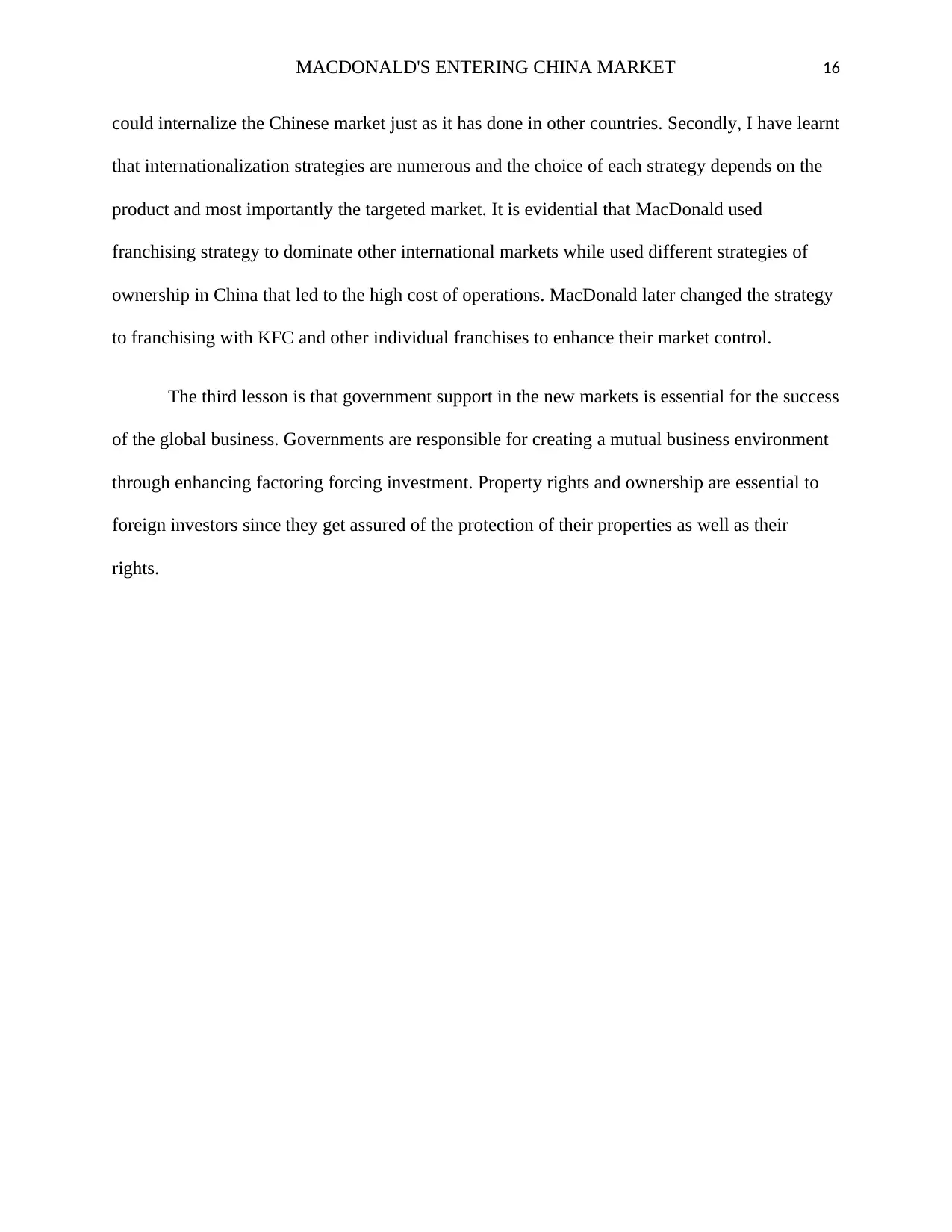
MACDONALD'S ENTERING CHINA MARKET 16
could internalize the Chinese market just as it has done in other countries. Secondly, I have learnt
that internationalization strategies are numerous and the choice of each strategy depends on the
product and most importantly the targeted market. It is evidential that MacDonald used
franchising strategy to dominate other international markets while used different strategies of
ownership in China that led to the high cost of operations. MacDonald later changed the strategy
to franchising with KFC and other individual franchises to enhance their market control.
The third lesson is that government support in the new markets is essential for the success
of the global business. Governments are responsible for creating a mutual business environment
through enhancing factoring forcing investment. Property rights and ownership are essential to
foreign investors since they get assured of the protection of their properties as well as their
rights.
could internalize the Chinese market just as it has done in other countries. Secondly, I have learnt
that internationalization strategies are numerous and the choice of each strategy depends on the
product and most importantly the targeted market. It is evidential that MacDonald used
franchising strategy to dominate other international markets while used different strategies of
ownership in China that led to the high cost of operations. MacDonald later changed the strategy
to franchising with KFC and other individual franchises to enhance their market control.
The third lesson is that government support in the new markets is essential for the success
of the global business. Governments are responsible for creating a mutual business environment
through enhancing factoring forcing investment. Property rights and ownership are essential to
foreign investors since they get assured of the protection of their properties as well as their
rights.
Secure Best Marks with AI Grader
Need help grading? Try our AI Grader for instant feedback on your assignments.
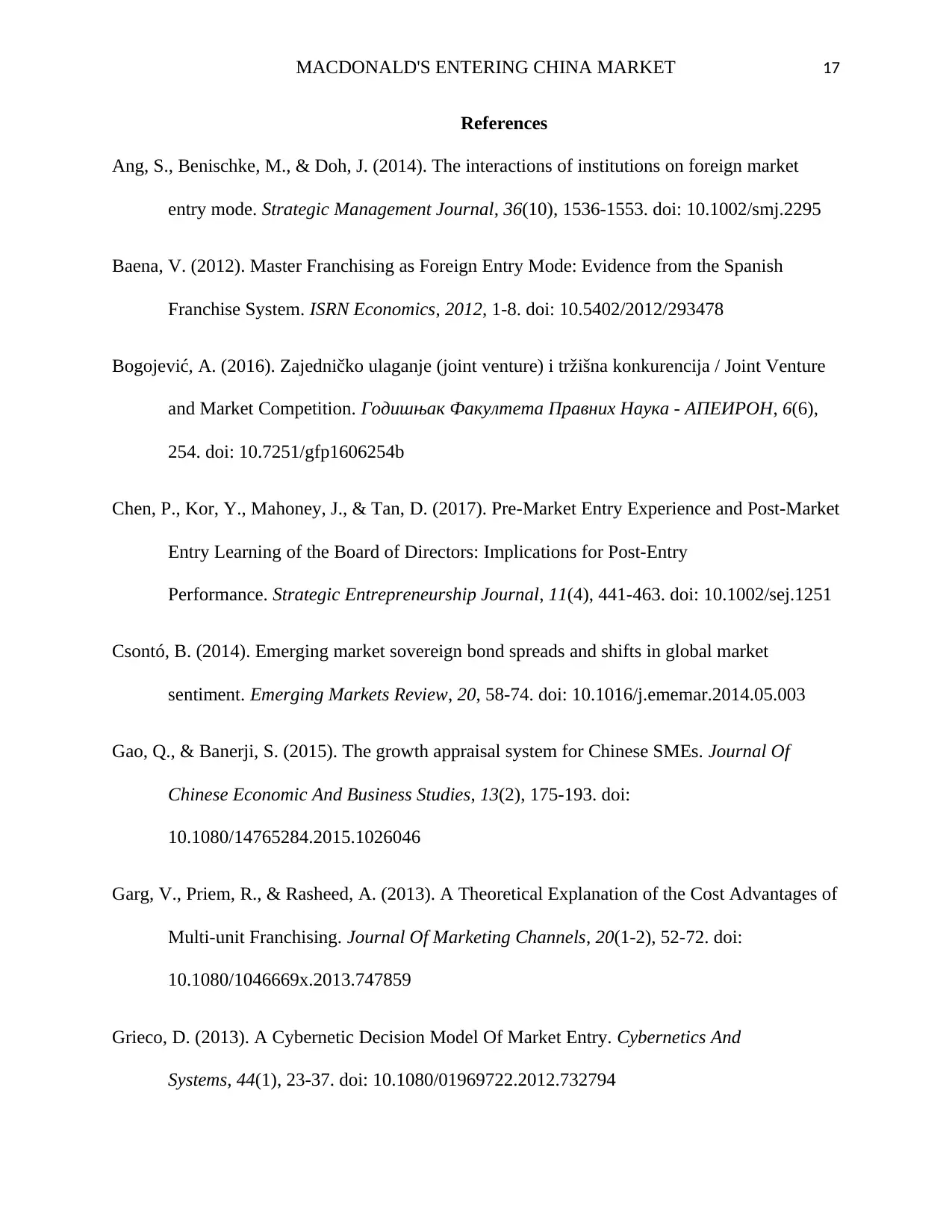
MACDONALD'S ENTERING CHINA MARKET 17
References
Ang, S., Benischke, M., & Doh, J. (2014). The interactions of institutions on foreign market
entry mode. Strategic Management Journal, 36(10), 1536-1553. doi: 10.1002/smj.2295
Baena, V. (2012). Master Franchising as Foreign Entry Mode: Evidence from the Spanish
Franchise System. ISRN Economics, 2012, 1-8. doi: 10.5402/2012/293478
Bogojević, A. (2016). Zajedničko ulaganje (joint venture) i tržišna konkurencija / Joint Venture
and Market Competition. Годишњак Факултета Правних Наука - АПЕИРОН, 6(6),
254. doi: 10.7251/gfp1606254b
Chen, P., Kor, Y., Mahoney, J., & Tan, D. (2017). Pre-Market Entry Experience and Post-Market
Entry Learning of the Board of Directors: Implications for Post-Entry
Performance. Strategic Entrepreneurship Journal, 11(4), 441-463. doi: 10.1002/sej.1251
Csontó, B. (2014). Emerging market sovereign bond spreads and shifts in global market
sentiment. Emerging Markets Review, 20, 58-74. doi: 10.1016/j.ememar.2014.05.003
Gao, Q., & Banerji, S. (2015). The growth appraisal system for Chinese SMEs. Journal Of
Chinese Economic And Business Studies, 13(2), 175-193. doi:
10.1080/14765284.2015.1026046
Garg, V., Priem, R., & Rasheed, A. (2013). A Theoretical Explanation of the Cost Advantages of
Multi-unit Franchising. Journal Of Marketing Channels, 20(1-2), 52-72. doi:
10.1080/1046669x.2013.747859
Grieco, D. (2013). A Cybernetic Decision Model Of Market Entry. Cybernetics And
Systems, 44(1), 23-37. doi: 10.1080/01969722.2012.732794
References
Ang, S., Benischke, M., & Doh, J. (2014). The interactions of institutions on foreign market
entry mode. Strategic Management Journal, 36(10), 1536-1553. doi: 10.1002/smj.2295
Baena, V. (2012). Master Franchising as Foreign Entry Mode: Evidence from the Spanish
Franchise System. ISRN Economics, 2012, 1-8. doi: 10.5402/2012/293478
Bogojević, A. (2016). Zajedničko ulaganje (joint venture) i tržišna konkurencija / Joint Venture
and Market Competition. Годишњак Факултета Правних Наука - АПЕИРОН, 6(6),
254. doi: 10.7251/gfp1606254b
Chen, P., Kor, Y., Mahoney, J., & Tan, D. (2017). Pre-Market Entry Experience and Post-Market
Entry Learning of the Board of Directors: Implications for Post-Entry
Performance. Strategic Entrepreneurship Journal, 11(4), 441-463. doi: 10.1002/sej.1251
Csontó, B. (2014). Emerging market sovereign bond spreads and shifts in global market
sentiment. Emerging Markets Review, 20, 58-74. doi: 10.1016/j.ememar.2014.05.003
Gao, Q., & Banerji, S. (2015). The growth appraisal system for Chinese SMEs. Journal Of
Chinese Economic And Business Studies, 13(2), 175-193. doi:
10.1080/14765284.2015.1026046
Garg, V., Priem, R., & Rasheed, A. (2013). A Theoretical Explanation of the Cost Advantages of
Multi-unit Franchising. Journal Of Marketing Channels, 20(1-2), 52-72. doi:
10.1080/1046669x.2013.747859
Grieco, D. (2013). A Cybernetic Decision Model Of Market Entry. Cybernetics And
Systems, 44(1), 23-37. doi: 10.1080/01969722.2012.732794

MACDONALD'S ENTERING CHINA MARKET 18
Hollender, L., Zapkau, F., & Schwens, C. (2015). SME Foreign Market Entry Mode Choice and
Foreign Venture Performance. Academy Of Management Proceedings, 2015(1), 14356.
doi: 10.5465/ambpp.2015.14356abstract
Jiang, H., Qiang, M., Fan, Q., & Zhang, M. (2018). Scientific research driven by large-scale
infrastructure projects: A case study of the Three Gorges Project in China. Technological
Forecasting And Social Change, 134, 61-71. doi: 10.1016/j.techfore.2018.05.012
Josephi, B. (2013). Book Review: China's Environment & China's Environment
Journalists. Media International Australia, 146(1), 159-160. doi:
10.1177/1329878x1314600123
Kazlauskaite, R., Abramavicius, S., Sarapovas, T., Gelbuda, M., & Venciūtė, D. (2015).
Network Research On Internatinalization Of Firms From The Emerging Economies:
Literature Review And Propositions. European Journal Of Business And
Economics, 10(1). doi: 10.12955/ejbe.v9i2.548
Lin, W. (2012). Family ownership and internationalization processes: Internationalization pace,
internationalization scope, and internationalization rhythm. European Management
Journal, 30(1), 47-56. doi: 10.1016/j.emj.2011.10.003
Ram, R. (2015). PPP GDP Per Capita for Countries of the World: A Comparison of the New ICP
Results with World Bank Data. Social Indicators Research, 127(3), 1057-1066. doi:
10.1007/s11205-015-1009-3
Resmini, L., & Siedschlag, I. (2013). Is foreign direct investment to China crowding out the
foreign direct investment to other countries?. China Economic Review, 25, 1-16. doi:
10.1016/j.chieco.2012.12.003
Hollender, L., Zapkau, F., & Schwens, C. (2015). SME Foreign Market Entry Mode Choice and
Foreign Venture Performance. Academy Of Management Proceedings, 2015(1), 14356.
doi: 10.5465/ambpp.2015.14356abstract
Jiang, H., Qiang, M., Fan, Q., & Zhang, M. (2018). Scientific research driven by large-scale
infrastructure projects: A case study of the Three Gorges Project in China. Technological
Forecasting And Social Change, 134, 61-71. doi: 10.1016/j.techfore.2018.05.012
Josephi, B. (2013). Book Review: China's Environment & China's Environment
Journalists. Media International Australia, 146(1), 159-160. doi:
10.1177/1329878x1314600123
Kazlauskaite, R., Abramavicius, S., Sarapovas, T., Gelbuda, M., & Venciūtė, D. (2015).
Network Research On Internatinalization Of Firms From The Emerging Economies:
Literature Review And Propositions. European Journal Of Business And
Economics, 10(1). doi: 10.12955/ejbe.v9i2.548
Lin, W. (2012). Family ownership and internationalization processes: Internationalization pace,
internationalization scope, and internationalization rhythm. European Management
Journal, 30(1), 47-56. doi: 10.1016/j.emj.2011.10.003
Ram, R. (2015). PPP GDP Per Capita for Countries of the World: A Comparison of the New ICP
Results with World Bank Data. Social Indicators Research, 127(3), 1057-1066. doi:
10.1007/s11205-015-1009-3
Resmini, L., & Siedschlag, I. (2013). Is foreign direct investment to China crowding out the
foreign direct investment to other countries?. China Economic Review, 25, 1-16. doi:
10.1016/j.chieco.2012.12.003
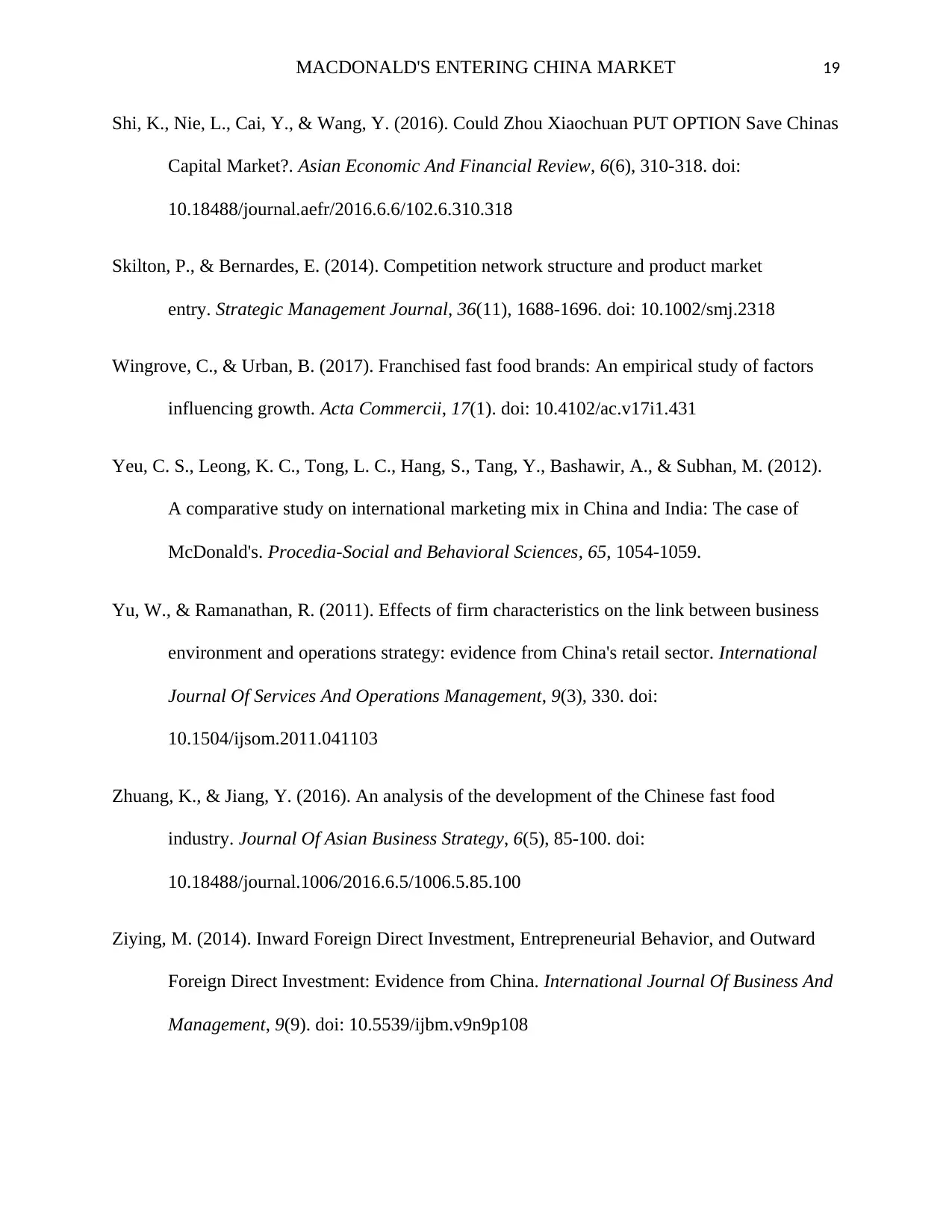
MACDONALD'S ENTERING CHINA MARKET 19
Shi, K., Nie, L., Cai, Y., & Wang, Y. (2016). Could Zhou Xiaochuan PUT OPTION Save Chinas
Capital Market?. Asian Economic And Financial Review, 6(6), 310-318. doi:
10.18488/journal.aefr/2016.6.6/102.6.310.318
Skilton, P., & Bernardes, E. (2014). Competition network structure and product market
entry. Strategic Management Journal, 36(11), 1688-1696. doi: 10.1002/smj.2318
Wingrove, C., & Urban, B. (2017). Franchised fast food brands: An empirical study of factors
influencing growth. Acta Commercii, 17(1). doi: 10.4102/ac.v17i1.431
Yeu, C. S., Leong, K. C., Tong, L. C., Hang, S., Tang, Y., Bashawir, A., & Subhan, M. (2012).
A comparative study on international marketing mix in China and India: The case of
McDonald's. Procedia-Social and Behavioral Sciences, 65, 1054-1059.
Yu, W., & Ramanathan, R. (2011). Effects of firm characteristics on the link between business
environment and operations strategy: evidence from China's retail sector. International
Journal Of Services And Operations Management, 9(3), 330. doi:
10.1504/ijsom.2011.041103
Zhuang, K., & Jiang, Y. (2016). An analysis of the development of the Chinese fast food
industry. Journal Of Asian Business Strategy, 6(5), 85-100. doi:
10.18488/journal.1006/2016.6.5/1006.5.85.100
Ziying, M. (2014). Inward Foreign Direct Investment, Entrepreneurial Behavior, and Outward
Foreign Direct Investment: Evidence from China. International Journal Of Business And
Management, 9(9). doi: 10.5539/ijbm.v9n9p108
Shi, K., Nie, L., Cai, Y., & Wang, Y. (2016). Could Zhou Xiaochuan PUT OPTION Save Chinas
Capital Market?. Asian Economic And Financial Review, 6(6), 310-318. doi:
10.18488/journal.aefr/2016.6.6/102.6.310.318
Skilton, P., & Bernardes, E. (2014). Competition network structure and product market
entry. Strategic Management Journal, 36(11), 1688-1696. doi: 10.1002/smj.2318
Wingrove, C., & Urban, B. (2017). Franchised fast food brands: An empirical study of factors
influencing growth. Acta Commercii, 17(1). doi: 10.4102/ac.v17i1.431
Yeu, C. S., Leong, K. C., Tong, L. C., Hang, S., Tang, Y., Bashawir, A., & Subhan, M. (2012).
A comparative study on international marketing mix in China and India: The case of
McDonald's. Procedia-Social and Behavioral Sciences, 65, 1054-1059.
Yu, W., & Ramanathan, R. (2011). Effects of firm characteristics on the link between business
environment and operations strategy: evidence from China's retail sector. International
Journal Of Services And Operations Management, 9(3), 330. doi:
10.1504/ijsom.2011.041103
Zhuang, K., & Jiang, Y. (2016). An analysis of the development of the Chinese fast food
industry. Journal Of Asian Business Strategy, 6(5), 85-100. doi:
10.18488/journal.1006/2016.6.5/1006.5.85.100
Ziying, M. (2014). Inward Foreign Direct Investment, Entrepreneurial Behavior, and Outward
Foreign Direct Investment: Evidence from China. International Journal Of Business And
Management, 9(9). doi: 10.5539/ijbm.v9n9p108
Paraphrase This Document
Need a fresh take? Get an instant paraphrase of this document with our AI Paraphraser
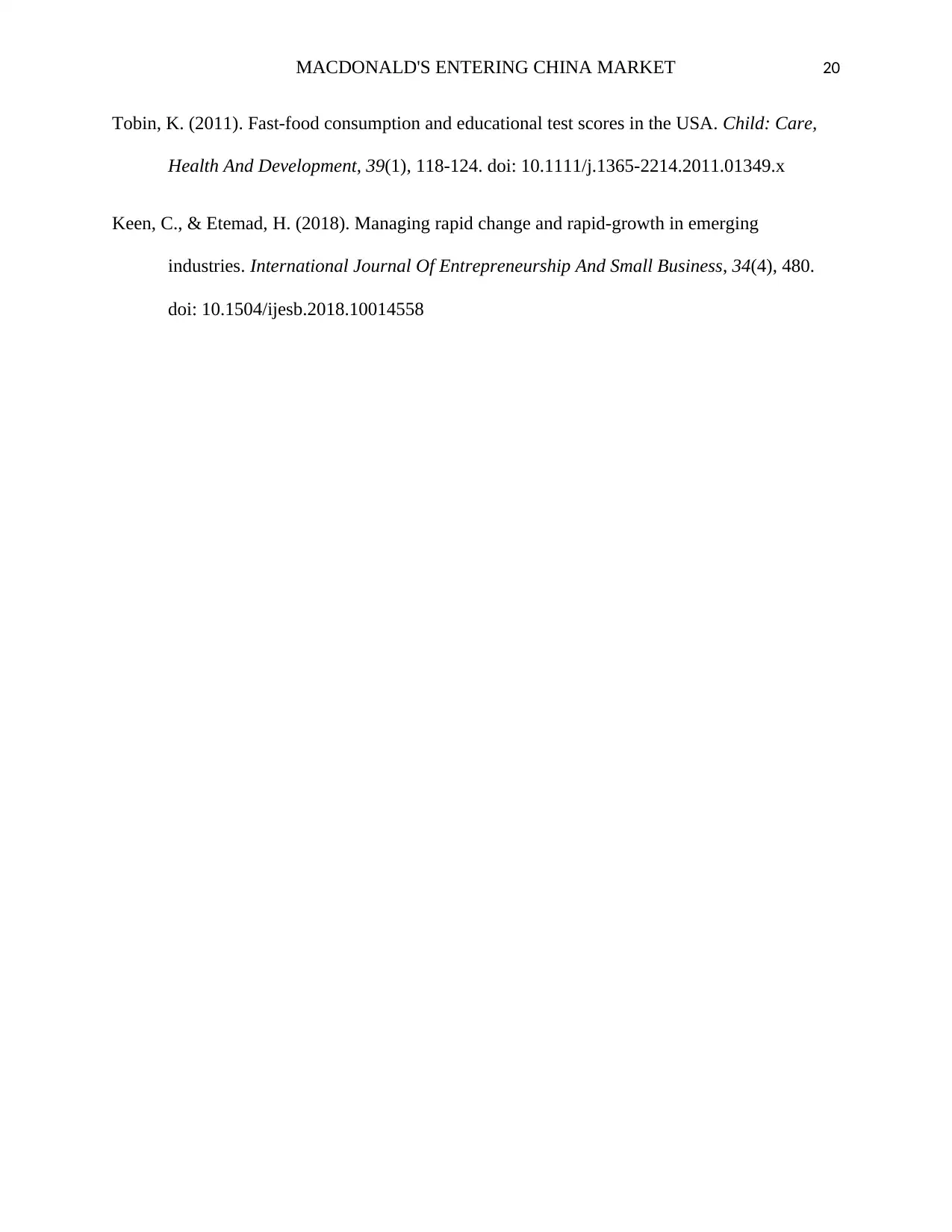
MACDONALD'S ENTERING CHINA MARKET 20
Tobin, K. (2011). Fast-food consumption and educational test scores in the USA. Child: Care,
Health And Development, 39(1), 118-124. doi: 10.1111/j.1365-2214.2011.01349.x
Keen, C., & Etemad, H. (2018). Managing rapid change and rapid-growth in emerging
industries. International Journal Of Entrepreneurship And Small Business, 34(4), 480.
doi: 10.1504/ijesb.2018.10014558
Tobin, K. (2011). Fast-food consumption and educational test scores in the USA. Child: Care,
Health And Development, 39(1), 118-124. doi: 10.1111/j.1365-2214.2011.01349.x
Keen, C., & Etemad, H. (2018). Managing rapid change and rapid-growth in emerging
industries. International Journal Of Entrepreneurship And Small Business, 34(4), 480.
doi: 10.1504/ijesb.2018.10014558
1 out of 20
Related Documents
Your All-in-One AI-Powered Toolkit for Academic Success.
+13062052269
info@desklib.com
Available 24*7 on WhatsApp / Email
![[object Object]](/_next/static/media/star-bottom.7253800d.svg)
Unlock your academic potential
© 2024 | Zucol Services PVT LTD | All rights reserved.





